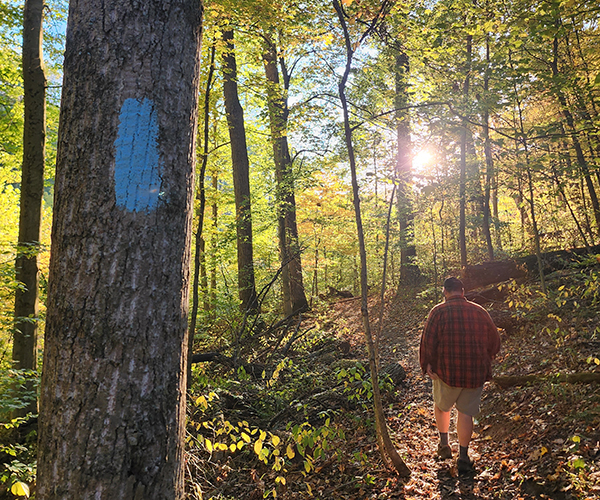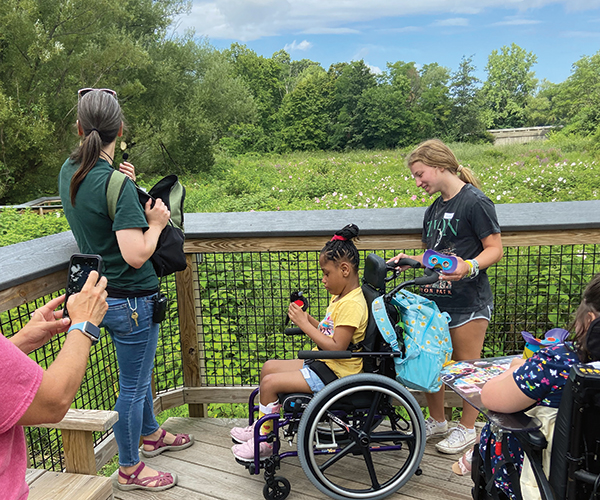The Raptor Keeper
Kelly Bauer,
Lorain County Metro Parks
Kelly Bauer puts on a glove about twice the thickness of an oven mitt and heads toward an outdoor cage.
Inside is Oliver, the resident barred owl in the Raptor Center, a sequence of birdcages at the Carlisle Reservation in LaGrange and part of the Lorain County Metro Parks. Housed here are 11 birds of prey from across the country, all permanently injured after they hit manmade objects.
A naturalist who stumbled upon zoology as a sophomore at John Carroll University, Bauer, 26, was put in charge of the Raptor Center last May. She works with its founder, Roy Hartman, to care for the birds and develop educational programs so students can view them up close.
With the help of volunteers, Bauer feeds the birds every day and brings them out of their night cages.
"They all have very different personalities," she says. "They all have their 'don't touch me' days. That's a challenge when you're in a hurry and have to go to a program."
But soon, Oliver is perched on Bauer's gloved hand. Bauer gently and firmly smooths back one wing and points out the second, useless one. Oliver's left wing was destroyed after he slammed into a car. He can't fly and often loses his balance.
A serene Oliver, living up to the image of a "wise owl," looks off into the distance.
That calm could vanish in a second.
"The birds are trained to be near us," Bauer notes, "but they're still wild."
— Charu Gupta
The Photographer
Ian Adams,
parks across Ohio
Environmental photographer Ian Adams has traveled more than 500,000 miles in Ohio to capture its most stunning landscapes. With nine books published and five more due to be printed in the next year, it seems as if no wildflower meadow, fog-drenched swamp or rushing waterfall in the state has escaped his lens.
His work began as a hobby that stemmed from a love for hiking, a pastime he began in his native England. Adams, who has an MBA, moved to Northeast Ohio — his mother's birthplace — 30 years ago to work in information technology.
In 1979, he spent his company bonus on $10,000 worth of photography equipment and his hobby turned into his passion.
"I had no idea what I was doing, but I had a lot of books," says Adams, 57, sitting across from a full floor-to-ceiling bookcase in his small Cuyahoga Falls ranch house.
Much has changed since those early days. He rarely hikes through the parks looking for subjects anymore: His focus is now dictated by his book projects. Sometimes, though, he still straps on hip-high wader boots to chase down two of his favorite living subjects: butterflies and dragonflies.
Even though the parks have become Adams' worksites, he says they still remain a spiritual sanctuary for him.
"I like to go out there and just hike," he says. "When I do that, I leave my cameras at home."
— Jacqueline Marino
The Park Officer
Jim Fischbach,
Cleveland Lakefront State Park
When Jim Fischbach was growing up in rural Geauga County, two things helped determine his future profession: the great expanse of nature outside his house and the police radio inside it.
Fischbach was raised in a law-enforcement family. His father was the local part-time police chief and his mother was the dispatcher. When an uncle, a park ranger at Punderson Lake, told Fischbach about a similar position opening at Cleveland Lakefront State Park, Fischbach thought the job would be "pitching tents and chopping firewood," a perfect niche for a country boy like himself.
But he soon realized that wasn't the case. "I was pulling people out of cars," he says — making arrests.
That was the reality of patrolling an urban park in 1979 -- and so it remains in 2004. Fischbach, 47, wears an earthy-green uniform, but he also carries a gun. His dirt-stained hands have made scores of arrests for speeding, indecency, drugs and other criminal offenses.
While state park officers in more remote areas direct campers, Fischbach's job is less about helping visitors enjoy the natural world than keeping them from ruining it.
Ultimately, though, the diversity of the urban park officer's activities distinguishes him from the city patrolman. In 25 years, Fischbach has rescued deer from Lake Erie, found children who wandered away from family picnics, helped contain marsh fires in Mentor and participated in the cleanup of the lakefront.
"When I started here, Edgewater had gray sand because it was so polluted," he recalls. "Whiskey Island was a garbage dump. • Euclid Creek used to run red."
Fischbach helped clean up some of those areas. Now, he can see the results.
"It made a difference," he says.
— JM
The Volunteer
Bert Szabo,
Summit County Metro Parks
Imagine spending most of your career at one job. Imagine that, in your work, you leave a secret signature, the fruits of your ideas, all around for everyone to see, so that, toward the end of your career, you can take a walk among all the ways you've guided nature's hand.
You'd be Bert Szabo, the Metro Parks serving Summit County's ambassador to the public for decades. He became a park manager in 1957 and started taking school groups on the trails to explain nature's patterns. The parks system noticed and made him its first naturalist in 1964. That same year, he helped organize the Metro Parks' first Fall Hiking Spree, and he's one of 21 hikers who have participated every year since.
Szabo named most of the trails, and some of the parks, in Summit's 12-park system. Since Szabo joined, the Metro Parks has doubled in size. He had a hand in all the new development, even planning the F.A. Seiberling Naturealm, an arboretum and nature-stuûy area created on a former farm. Meanwhile, he and his assistants guided nature walks and bird walks for schools, garden clubs and scouting groups. His meticulous archives show, for instance, that they talked about the parks to 13,000 people in 1966.
Szabo retired in 1991, but even at age 83, he still volunteers to organize the archives and clear vines and invasive plants from his favorite parks.
On a recent morning, he walks a visitor through the Naturealm's nature center and looks out the window across Seneca Pond.
"I planted all those trees across the way," he says, indicating a towering stand of gray birches and white pines. Seeing them now is "awe-inspiring," he says. After that one thought for his legacy, Szabo becomes a guide again: "There's a goldfinch on that feeder," he says, pointing. "People call it the wild canary."
— Erick Trickey
The Bat Expert
Tim Krynak,
Cleveland Metroparks
Tim Krynak walks under the bat house, a dark wooden box atop a tall pole near a picnic shelter, and peers up. It's midday, so the bats are hiding, but Krynak can hear them shifting around and talking: rustle-rustle-rustle, squeak-squeak.
If he had his way, Krynak, the Cleveland Metroparks' bat expert, would work with bats full time. "They're very interesting animals, and we know very little about them," he enthuses. "Here's an animal that's out at night • and not only is it navigating through the forest, it's also catching insects that we could hardly even see.
"Here's an animal that can hibernate for six months," he continues, "that can lower and raise its body temperature almost at will."
A naturalist at the Rocky River Reservation's nature center, Krynak leads camps and hikes, answers questions and plans events. Then, every summer, when bats migrate back to Cleveland, he spends one day a week trapping and counting them. He strings up fine "mist nets" across bat flight paths. The bats hit the mesh and fall, dazed, into a pouch. Krynak weighs and measures them, figuring out their species, sex and age. He takes fur and tissue samples, sometimes puts radio collars or bands on them, then lets them go.
Night species of bats call the Metroparks home, Krynak says, from the big brown bat (with a 1-foot wingspan) to the Eastern pipistrelle (which weighs about 1/6 of an ounce) to the endangered Indiana bat. He studies whether bat populations are growing or shrinking and where they like to live. Around Halloween, he teaches schoolchildren about his winged, furry friends.
He counters fears with reassuring bat facts: Bats don't try to tangle themselves in your hair; they're just trying to eat the mosquitoes around you. Less than one in 200 bats has rabies. They won't bite unless you try to handle them. There are no blood-drinking bats in North America.
Oh, they're in Romania, right? "No, no, no!" he says, worked up: Latin America. Krynak's a bat purist with no patience for myths. What does he think of the Batman movies and the old TV show? "I love 'em! They're great!" he says. "They have nothing to do with bats, though!"
— ET
Krynak will lecture about bats and demonstrate bat-catching at the Cuyahoga Valley National Park's Kendall Lake on July 23. He'll also handle the bat portion of the North Chagrin Nature Center's "Nature at Night — Once in a Blue Moon" presentation July 31.
The Runner
Colin Fishwick,
Lorain County Metro Parks, Cleveland Metroparks
For Colin Fishwick, running is an addiction. And running in the park is a meditation.
The 26-year-old Willoughby native and Oberlin College graduate has been a runner since he was 17. Fishwick runs daily on local roads and, at least once a week, he uses the Lorain County Metro Parks' Carlisle Reservation in LaGrange.
"It's a little bit boring running in Oberlin," Fishwick says. "It's so flat. The Metro Parks are all the more important out here."
The park's scenic landscapes entice Fishwick, academic-services coordinator at Oberlin Community Services, a community organization that provides tutoring in Oberlin public schools.
"It keeps me motivated. Especially in a county that's urban or agricultural or suburban, there's not much forested land outside the parks," he says.
Fishwick's park runs are usually nine to 15 miles and last about 1-1/2 hours — slightly longer than his average daily run.
ï¬hen visiting his parents in Willoughby, Fishwick uses the Cleveland Metroparks' North Chagrin and South Chagrin reservations.
He says he loves the sound of his feet hitting the gravel paths and listening to the birds and horses. Not having to watch the roads for motor traffic is another plus. But most of all, running in the parks is a precious opportunity. Fishwick savors his afternoon runs — a contrast to the hectic schoolday.
"Everyone needs some alone time," he observes. "A time where they're not carrying on a conversation, and that's what it is for me."
— CG
The Historical Interpreter
Karen Lohman,
Hale Farm and Village, Cuyahoga Valley National Park
Another little one has died, and the people of Wheatfield mourn. Widow Sophronia Hadley, dressed in black, a knee-length veil covering her face, walks tearfully behind pall bearers carrying the tiny coffin of a child. Spectators respectfully remove their baseball caps.
Mrs. Hadley, really 55-year-old Karen Lohman of Hinckley Township, never leaves the year 1848 at Hale Farm and Village in Bath Township, located in Cuyahoga Valley National Park. As a first-person interpreter, it is Lohman's job to create and maintain Hadley's life in 1848. She pores over period diaries, books and magazines for the speech and philosophic hallmarks of Mrs. Hadley. The intent is to teach people about Western Reserve life and maintain her persona while conversing freely with visitors.
"I don't like to be called an actor because an actor implies a script, and I don't have a script," Lohman says. "I have a head stuffed full of mid-19th-century knowledge."
This year, she is completing her seventh season as Mrs. Hadley, a resident of Wheatfield, a fictitious village of preserved historic buildings. Hadley delights in interacting with people who are fascinated by her old ways. When some skimpily dressed young women ask her if she's hot in the summer, she replies, "Well, yes, but at least I look like a lady."
A former high-school French teacher, Lohman was looking for a job to help pay her children's tuition bills seven years ago. She responded to a newspaper ad that said, "Time Travelers Wanted."
"I'm a teacher at heart, but this is so much more fun than teaching in a classroom," she says. "And I get to wear a costume and play make-believe 40 hours a week."
— Jamie Carracher
The Trailgator
Ron Skrbin,
Geauga Park District
"What do you see, Ding?" Ron Skrbin asks in a sandpapery voice as the Doberman leaps forward, barking at the rustling sound in a nearby bush. As a "trailgator" for the Geauga Park District, Skrbin and his canine companion, Dinger, walk the trails of a 562-acre tract known as the Rookery each day at sunup. Skrbin, 69, scopes out litter and checks for fallen trees, while Dinger alerts him of wildlife ranging from the common squirrel — as was the case this past Earth Day morning — to the occasional fox or mink. After the excursion, Skrbin reports their findings to park administrators.
Rain or shine, Skrbin and Dinger haven't missed an outing in 2-1/2 years.
"There's no discussion about where we're going first thing in the morning," says the retired program-management worker for TRW military contractors. "I'm getting exercise, he's getting exercise and we're making sure the park is in good shape."
It's hard for the Russell resident to walk through the park without stopping every few feet to indulge his fascination with trout lilies, his awe of red-winged blackbirds and his penchant for pointing out Mother Nature's idiosyncrasies.
"See where the water ends out there? That's a beaver dam. The beavers created this pond," he says. "There's some real good woodworkers out there." With binoculars around his neck and Dinger at his side, Skrbin notices animals and plants that most park visitors — even the regulars — would miss.
He's been making rounds at the Rookery ever since the park opened seven years ago. His morning strolls, combined with the help he donates to nature-center programs, amount to an average of 20 hours of community service per week. As of November, he'd completed 1,500 volunteer hours. By now, Skrbin knows all the park regulars by name, and he can recognize what's new and budding on a daily basis.
Skrbin is one of 317 active volunteers in the Geauga Park District. He encourages others to find their niche and get involved, too. "Just call the park. They're always looking for volunteers," he says.
— Dalia Wheatt



